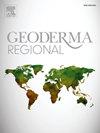Impact of sowing time of maize and ruzigrass intercropping systems on soil chemical, physical and microbiological properties in an Oxisol from southern Brazil
IF 3.3
2区 农林科学
Q2 SOIL SCIENCE
引用次数: 0
Abstract
The sowing time of ruzigrass (Urochloa ruziziensis) intercropped with maize (Zea mays L.) influences the above- and belowground biomass, affecting soil properties. This study evaluated the effects of sowing times of maize and ruzigrass on the physical, chemical, and microbiological properties in an Oxisol in southern Brazil. The sowing time included intercropping maize with ruzigrass (i) sown before maize, (ii) sown at the time of maize sowing, (iii) sown after maize, and was compared to the (iv) sole maize (control treatment). The soil physical (bulk density, total porosity, macroporosity, and saturated hydraulic conductivity), chemical (soil pH, soil organic matter, phosphorus, potassium, calcium, and magnesium), and microbiological properties (microbial biomass carbon, microbial biomass nitrogen, arylsulfatase, β-glucosidase, and acid and alkaline phosphatase activities) were analyzed after three years. Sowing time of maize with ruzigrass affected the competition between ruzigrass and maize and impacted soil properties. In the intercropping of ruzigrass sown before maize, the bulk density at the 10–20 cm depth was 10 % lower than in the sole maize. The benefits of intercropping maize with ruzigrass for bulk density, total porosity, macroporosity, microbial biomass, and enzyme activity were higher when ruzigrass was sown before and at the time of maize sowing than that of ruzigrass sown after maize and sole maize. Sowing of ruzigrass after maize sowing was less effective in improving the physical and microbiological properties of the soil. The changes in soil chemical properties under intercropping maize with ruzigrass took longer to be observed than the soil physical and microbiological properties, indicating that physical and microbiological properties are more sensitive indicators of soil quality. The results of this study can be used to guide integrated intercropping strategies in no-tillage cropping systems to maximize positive effects on soil quality.
玉米与紫穗草间作制度播期对巴西南部Oxisol土壤化学、物理和微生物特性的影响
玉米间作紫穗草的播期影响地上、地下生物量,影响土壤性质。本研究评估了玉米和穗草播种时间对巴西南部Oxisol土壤物理、化学和微生物特性的影响。播种时间包括(i)玉米播种前播种,(ii)玉米播种时播种,(iii)玉米播种后播种,并与(iv)单独玉米(对照处理)进行比较。土壤物理特性(容重、总孔隙度、大孔隙度和饱和导电性)、化学特性(土壤pH、土壤有机质、磷、钾、钙、镁)和微生物特性(微生物生物量碳、微生物生物量氮、芳基硫酸盐酶、β-葡萄糖苷酶、酸碱性磷酸酶活性)在3年后进行了分析。玉米穗草播期影响穗草与玉米的竞争,影响土壤性质。玉米前播紫穗草间作时,10 ~ 20 cm深度的容重比单播玉米低10%。玉米间作紫穗草对玉米容重、总孔隙度、大孔隙度、微生物量和酶活性的效益在玉米播前和播时均高于玉米播后和单玉米。玉米播后播紫穗草对改善土壤物理和微生物特性的效果较差。玉米与紫穗草间作土壤化学性质变化的观测时间较土壤物理和微生物性质变化的观测时间长,说明物理和微生物性质是土壤质量较为敏感的指标。本研究结果可用于指导免耕种植系统的综合间作策略,以最大限度地提高土壤质量。
本文章由计算机程序翻译,如有差异,请以英文原文为准。
求助全文
约1分钟内获得全文
求助全文
来源期刊

Geoderma Regional
Agricultural and Biological Sciences-Soil Science
CiteScore
6.10
自引率
7.30%
发文量
122
审稿时长
76 days
期刊介绍:
Global issues require studies and solutions on national and regional levels. Geoderma Regional focuses on studies that increase understanding and advance our scientific knowledge of soils in all regions of the world. The journal embraces every aspect of soil science and welcomes reviews of regional progress.
 求助内容:
求助内容: 应助结果提醒方式:
应助结果提醒方式:


